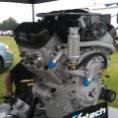A couple of things...
The Gen-1 engine weighed 141 pounds as displayed. The new one will be about 160, and estimated right at 200 with gearbox and accessories.
I have no business relationship with this company at this time, but encouraged Fritz to come to Mentone after he said he saw some real "beater" gyros at another event, and didn't think much of them. I do hope to offer them some marketing help longer-term, but we're early in that conversation.
The display engine used the 1.6L motorcycle castings. The engine dyno-tested before the show was a hybrid which used the Gen-1 case with the new, larger stroke crank, hence the 1.7L displacement. The new case allows larger bore for the quoted 1.9L final displacement. The first of the castings for the Gen-2 were only finalized a couple days before the show, and will not be received and built until a few weeks from now.
The new case has a 360º bellhousing adapter and includes provisions for a starter on the block side, automotive-style. There's also a new crank which extends a PTO out through the front for pulleys to drive accessories.
...The only problem I see and I mean the only problem it is a very high torque motor...The deadly torque roll is the only problem I see...
"High torque" is a relative term. Katech builds racing engines, and by racing (and motorcycle) standards this will be "high torque."
The torque created on the airframe has little to do with the engine's maximum available torque at low RPM. We're all used to dealing with automotive applications in which the driving wheels couple the drivetrain's full available torque to the ground, even at zero MPH. When driving a prop at idle where it has no "bite," the torque an engine can impart to the airframe when it revs is limited to the torque expended to spin up its internal rotating mass and that of the prop. That component of torque on the airframe lasts
only while RPM is rising.
When the prop has reached an RPM at which it starts moving a significant volume of air and loads the engine, the force creating twisting of the expelled airmass produces torque in the opposite direction on the airframe. That's the torque that's continuous during flight at high power settings, but it will be the same for any engine achieving the same HP at that RPM. Having abundant available low-end torque will allow quicker response to a throttle input, but is meaningless at higher RPM. Any engine producing 165 HP at 2500 prop RPM produces the same torque on the airframe at full power, even if one has significantly more torque at lower speeds.
The real issue in developing this engine for aviation use will be the unusual spacing of its firing pulses. That will require some sophistication in the gearbox. Whether an off-the-shelf unit is chosen or Katech designs its own will be determined by factors including damping effectiveness, output shaft location, durability, weight, cost, required lead time on orders, and the reliability of any third party provider as a supply-chain partner.






